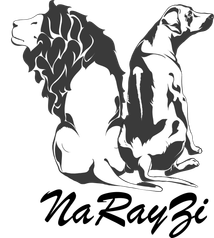
So, you brought home a puppy and are full of hopes that a year will fly by and he will become a big and beautiful dog! It will be so, but now all responsibility for ensuring that the puppy grows up healthy, strong and beautiful rests with you!
Rhodesian Ridgeback puppies are born from 400 to 700 gr. They grow rapidly and gain weight. By two months, the puppy has typically gained 8-12 kg. Most often, it is during this period that they leave for their new homes.
So, the three pillars of a healthy puppy:
The first pillar of health is nutrition. I recommend natural or formula feeding for dogs, but a good dry food suitable for your dog is also a great idea. An important factor when raising is the absence of overfeeding the puppy. Keep an eye on the dog’s condition and avoid excessive fatness — the age of the kitten has passed and now your pet is actively growing, and with it the load on its still unformed ligamentous apparatus, joints and cartilage tissue. Therefore, it is optimal if he is in a mild stage of underfeeding. This is also good because the lack of absolute satiation is an excellent motivator for developing obedience and training skills — let your baby always have a good appetite and a desire to learn. It must be remembered that healthy joints of a puppy are the correct ratio of calcium to phosphorus 1.5-2:1. Why is it so important to remember this ratio? Calcium is a building material for bones and teeth; it fights inflammation, strengthens the walls of blood vessels, participates in blood clotting, and ensures the functioning of the heart and skeletal muscles. Calcium enters the body with food. But for it to be absorbed, there must be enough phosphorus in the blood. If there is more phosphorus than necessary, calcium is actively removed from the body. If phosphorus is less than necessary, calcium is deposited on the walls of blood vessels, in bones, other organs and tissues. (during the puppy’s growth, I recommend taking a blood test at least twice: at the stage of teeth change — 3-4 months, and at the end of the change, at the age of 6-7 months)
The second pillar of healthy puppy growth is proper physical activity. You shouldn’t think that just because your baby wants to, you should let him run around to his heart’s content! “It’s a hound, ” they sometimes say to me. NO! He will become a hound after he grows up completely, gets stronger and the dog’s skeleton is formed, but for now he is a 2-month-old child who does not know how to correctly calculate his strength and does not know how to protect himself from danger.
Ideally, start teaching the puppy a leash and giving soft walking exercises to the puppy from the first moments when he appeared in your home. At first, walk around the apartment/house/in warm weather around the country house only on a short leash, at a walk, changing the speed of your step. Reinforce your baby’s enthusiasm with treats — this could be dry food, small pieces of meat, dried lung. Before training, first allow the puppy to walk for 5-10 minutes at will and relieve itself. After practicing walking at a pace on a leash, let your baby run freely for 5-10 minutes. This freedom is quite enough for a 2 month old baby.


After 2 vaccinations and quarantine at the age of 3.5 months, your puppy is already accustomed to a leash and movement nearby (this is not yet the “near” command, but its basics) and can begin to walk outside. Through training, begin to develop the necessary obedience, focusing on the owner in the event of obvious irritants — this is the third “whale” of responsible raising of a puppy. It is advisable for the first time to also have a short leash of 1.5 meters, a very well secured collar, and also a second long leash (3-5 m). This leash can be attached with a carabiner some time after the first walks only when you are sure that the dog is not afraid and feels confident. For the first 2-3 weeks, teach the puppy to walk side by side, changing speed every 300-500 meters and, as the dog grows, increase the intervals between walking loads. Proper walks on a short leash will help your puppy develop a good muscle corset, strengthen ligaments, joints and muscle mass.
I highly DO NOT recommend free-range walks with “friends”! “Friends” usually come in different ages and sizes and can cause significant injuries with their weight in games — subluxations, dislocations, which can lead to more tragic consequences.Please remember — your puppy has already played enough with his littermates in the kennel and now he is your dog! During puppyhood, the pet gets used to walking with you, playing with you, commands, proper behavior on the street and in public places.
Enjoy activities with your dog, but avoiding extremes, introduce your pet to other (good-natured dogs of adequate size) on walks on a loose leash, under your control. Only occasionally reward the puppy with free play with another dog for 5-10 minutes.
Remember, a properly raised and healthy puppy will turn into a beautiful, obedient and strong young dog within a year. Believe me, after a year your dog will be able to run as much as he wants, but he will always hear you and will not disappoint you with his movements!
With all my heart I wish your dog health and a happy life!


